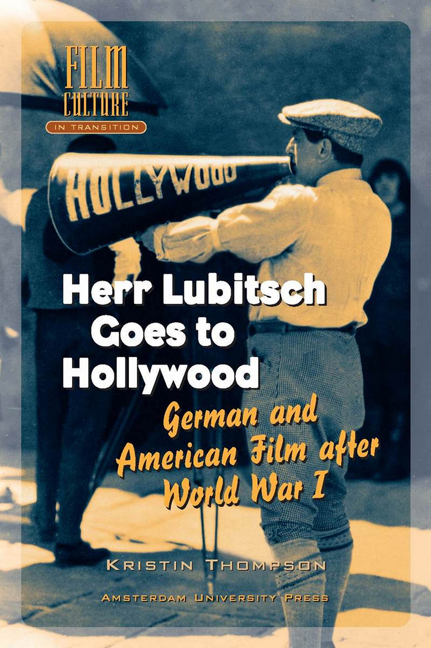Book contents
- Frontmatter
- Dedication
- Contents
- Acknowledgements
- Introduction
- Chapter One Lubitsch’s Career
- Chapter Two Making the Light Come from the Story: Lighting
- Chapter Three Subduing the Cluttered Background: Set Design
- Chapter Four Guiding the Viewer’s Attention: Editing
- Chapter Five Peeking at the Players: Acting
- Chapter Six Mutual Influences
- Epilogue: The Lubitsch Touch
- Notes
- Filmography
- Index
- Film Culture in Transition
- Plate Section
Chapter Four - Guiding the Viewer’s Attention: Editing
Published online by Cambridge University Press: 14 January 2021
- Frontmatter
- Dedication
- Contents
- Acknowledgements
- Introduction
- Chapter One Lubitsch’s Career
- Chapter Two Making the Light Come from the Story: Lighting
- Chapter Three Subduing the Cluttered Background: Set Design
- Chapter Four Guiding the Viewer’s Attention: Editing
- Chapter Five Peeking at the Players: Acting
- Chapter Six Mutual Influences
- Epilogue: The Lubitsch Touch
- Notes
- Filmography
- Index
- Film Culture in Transition
- Plate Section
Summary
Lubitsch the Editor
Figure 4.1 offers a rare glimpse of Lubitsch in the editing room, working in 1922 on Die Flamme. This scene was obviously posed for the publicity camera, but it serves to indicate how very little equipment was involved in this stage of filmmaking. Editors in Hollywood, had by this point already rigged up small viewers by cannibalizing old cameras and projectors. The first regular sales of the Moviola editing machine began in 1924. During the post-war years, however, Germans edited by eye, just as Lubitsch and his colleagues are shown doing here.
In Germany, labor was divided differently than it was in the US. In Hollywood, from the mid-1910s onward, there was a separate editor who often had assistants. The introduction of this new specialist arose largely because of the standardization of the feature film in 1915-1916. But although features became common in Germany from the early 1910s on, the role of chief editor remained with the director. Assembly began with assistants cutting the camera rolls into individual shots and labeling them. After the director chose which takes to use, another assistant spliced them together into a scene. This assistant, seen in Figure 4.1 at the left, was usually female, and she was termed die Kleberin (literally “the gluer”).
We are also fortunate to have a vivid contemporary description of Lubitsch at work in the editing room in a 1922 Photoplay article by an American journalist who observed part of the making of DIE FLAMME. The author has been discussing Lubitsch's great energy on the set during filming, and he goes on to discuss his behavior in the editing room:
If Lubitsch is a fast stepper on the “set,” he certainly is a shimmie dancer in the cutting room. You would imagine he was mad at the film. He tears at it until you almost think you hear him growl. Now and then he holds it up to the light and gives a blink – swish, crackle, zip – and another five hundred feet goes a-reeling. “The Flame of Love,” the Negri picture he just finished, required about three days to cut and assemble. Any other director I’ve ever observed would take two weeks for an ordinary program feature. “The Love of Pharaoh,” originally in ten or twelve reels, required less than a week.
- Type
- Chapter
- Information
- Herr Lubitsch Goes to HollywoodGerman and American Film after World War I, pp. 71 - 90Publisher: Amsterdam University PressPrint publication year: 2005



